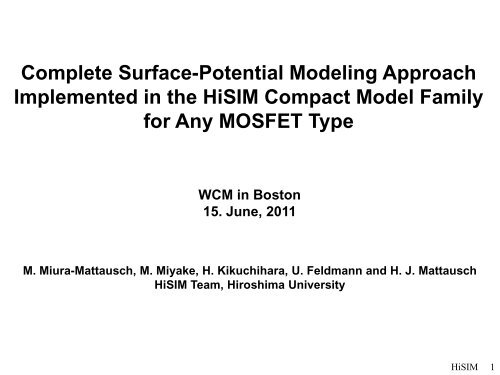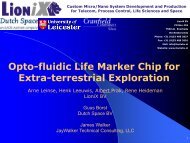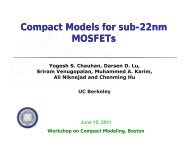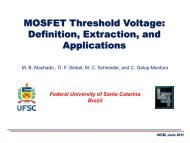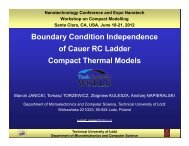HiSIM-SOI - TechConnect World
HiSIM-SOI - TechConnect World
HiSIM-SOI - TechConnect World
Create successful ePaper yourself
Turn your PDF publications into a flip-book with our unique Google optimized e-Paper software.
Complete Surface-Potential Modeling Approach<br />
Implemented in the <strong>HiSIM</strong> Compact Model Family<br />
for Any MOSFET Type<br />
WCM in Boston<br />
15. June, 2011<br />
M. Miura-Mattausch, M. Miyake, H. Kikuchihara, U. Feldmann and H. J. Mattausch<br />
<strong>HiSIM</strong> Team, Hiroshima University<br />
<strong>HiSIM</strong> 1
Basic Device Equations<br />
s<br />
• Gradual-Channel Approximation<br />
• Charge-Sheet Approximation<br />
reduced to surface potential φ s<br />
<strong>HiSIM</strong> 2
Property of Surface-Potential Model<br />
Q(φ)<br />
=<br />
ν = μ E: velocity<br />
: mobility<br />
The surface potential consistently determines charges,<br />
capacitances and currents under all operating conditions.<br />
<strong>HiSIM</strong> 3
Relationship among Device Properties<br />
(at drain side)<br />
(at source side)<br />
<strong>HiSIM</strong> 4
Specific Feature of Surface-potential Model<br />
one equation for all bias conditions<br />
<strong>HiSIM</strong> 5
Model Extraction for 45nm Technology<br />
W g /L g =2μm/200nm<br />
W g /L g =2μm/40nm<br />
Measurement<br />
<strong>HiSIM</strong>2<br />
one model for any device sizes without binning<br />
<strong>HiSIM</strong> 6
Current Derivatives for 45nm Technology<br />
Measurement<br />
<strong>HiSIM</strong><br />
W g /L g =<br />
2μm/40nm<br />
Beyond the 45nm generation nonphysical effects<br />
are getting obvious.<br />
<strong>HiSIM</strong> 7
Universal Mobility<br />
V ds =0.1V<br />
impurity concentration<br />
carrier concentration<br />
carrier mobility<br />
<strong>HiSIM</strong> 8
Requirements for RF Applications<br />
Harmonic Distortions<br />
Non-Quasi-Static Effect<br />
Noise Characteristics<br />
<strong>HiSIM</strong> 9
Feature of Potential-Based Model<br />
Current Equation: I = qnμE<br />
All physical quantities are function of surface potentials.<br />
Solution of Poisson’s Equation<br />
Important RF characteristics are originated by<br />
the potential distribution along the channel.<br />
I-V characteristics reflect all important RF properties.<br />
Accurate parameter extraction for I-V characteristics<br />
is important.<br />
S. Matsumoto et al., IEIEC T E, E88-C, p. 247, 2005.<br />
S. Hosokawa et al., Ext. Abs. SSDM, pp. 20, 2003.<br />
M. Miura-Mattausch et al., IEEE TED, 2006.<br />
<strong>HiSIM</strong> 10
Descendant of MOSFET<br />
MG-MOSFET<br />
SOTB-MOSFET<br />
TFT<br />
<strong>SOI</strong>-MOSFET<br />
MOSFET<br />
HV-MOSFET<br />
MOS-Varactor<br />
IGBT<br />
<strong>HiSIM</strong> 11
<strong>HiSIM</strong> Family<br />
Bulk-MOSFET<br />
<strong>HiSIM</strong>2<br />
High-Voltage MOSFET<br />
<strong>HiSIM</strong>_HV<br />
<strong>SOI</strong> MOSFET<br />
<strong>HiSIM</strong>-<strong>SOI</strong><br />
Thin-Film Transistor<br />
Double-Gate MOSFET<br />
Insulated-Gate Bipolar Transistor<br />
<strong>HiSIM</strong>-TFT<br />
<strong>HiSIM</strong>-DG<br />
<strong>HiSIM</strong>-IGBT<br />
<strong>HiSIM</strong><br />
12
<strong>SOI</strong>-MOSFET Modeling<br />
many possible conditions<br />
Si<br />
Si substrate<br />
<strong>HiSIM</strong><br />
13
Poisson’s Equation + Gauss’s Law<br />
V<br />
φ<br />
φ<br />
gs fb s,<strong>SOI</strong><br />
b,<strong>SOI</strong><br />
s,<strong>SOI</strong><br />
Q+Q + Q + Q<br />
- V = φ -<br />
CFOX<br />
Qs,bulk<br />
= φs,bulk<br />
-<br />
CBOX<br />
1<br />
Q<br />
s,bulk<br />
+ Qdep<br />
= φ<br />
2<br />
b,<strong>SOI</strong><br />
-<br />
C<br />
i dep b,<strong>SOI</strong> s,bulk<br />
<strong>SOI</strong><br />
Three surface potentials are solved<br />
simultaneously by iteration.<br />
Q b,<strong>SOI</strong><br />
φ b.<strong>SOI</strong><br />
φ s.<strong>SOI</strong><br />
Calculation results<br />
<strong>HiSIM</strong><br />
14
Smooth Transition among Conditions<br />
T <strong>SOI</strong> T BOX Conditi<br />
on<br />
Device1 150 110 PD<br />
Device2 50 110 DD<br />
Device3 50 50 DD<br />
Device4 25 110 FD<br />
<strong>HiSIM</strong><br />
15
C-V Characteristics<br />
T <strong>SOI</strong> =150nm<br />
T BOX =110nm<br />
: <strong>HiSIM</strong>-<strong>SOI</strong><br />
: 2D-Device Sim.<br />
T <strong>SOI</strong> =50nm<br />
T BOX =110nm<br />
T <strong>SOI</strong> =50nm<br />
T BOX =50nm<br />
DEVICE1<br />
DEVICE2<br />
T <strong>SOI</strong> =25nm<br />
T BOX =110nm<br />
DEVICE3<br />
DEVICE4<br />
<strong>HiSIM</strong><br />
16
Potential Distribution in Thin-Body MOSFET<br />
device surface<br />
insulator<br />
Back surface potential is strongly dependent on T <strong>SOI</strong> .<br />
Consistent solution of Poisson’s equation<br />
<strong>HiSIM</strong><br />
17
Device 4: Thin-Body <strong>SOI</strong>-MOSFET<br />
back-gate bias V bs dependence<br />
V bs<br />
φ b.<strong>SOI</strong><br />
φ s.<strong>SOI</strong><br />
<strong>HiSIM</strong><br />
18
Floating-Body Effect<br />
φ b.<strong>SOI</strong> is unstable.<br />
symbol: 2D-Sim.<br />
line: <strong>HiSIM</strong>-<strong>SOI</strong><br />
<strong>SOI</strong><br />
bulk<br />
φ s.bulk<br />
φ b.<strong>SOI</strong><br />
φ s.<strong>SOI</strong><br />
BOX<br />
φ b.<strong>SOI</strong> reduction change from FD to PD<br />
<strong>HiSIM</strong><br />
19
Charge Accumulation<br />
Impact Ionization:<br />
• Include accumulation charge in the Poisson equation<br />
• Increase the surface potential φ s0.<strong>SOI</strong><br />
• Increase the inversion charge Q i according to V ds increase<br />
<strong>HiSIM</strong><br />
20
History Effect<br />
Transient Characteristics of the Floating-Body Effect<br />
Τ d : Time constant of Q h accumulation<br />
T d<br />
H. Toda et al., SSDM 2010.<br />
<strong>HiSIM</strong><br />
21
I d -V d Comparison with Measurements<br />
gds gds’ gds’’<br />
V sub = 0.0V V sub = 0.0V V sub = 0.0V V sub = 0.0V<br />
V sub = -1.5V V sub = -1.5V V sub = -1.5V V sub = -1.5V<br />
measurement<br />
<strong>HiSIM</strong>-<strong>SOI</strong><br />
<strong>HiSIM</strong><br />
22
I d -V d Characteristics as a function of N <strong>SOI</strong><br />
W g =0.25mm, L g =0.15mm<br />
N <strong>SOI</strong> (cm -3 ) = 1.0e16 2.0e16 5.0e16<br />
Vds<br />
Vds<br />
Vds<br />
Vds<br />
Vds<br />
Vds<br />
Ids<br />
Ids<br />
Ids<br />
Ids<br />
Ids<br />
Ids<br />
Ids<br />
1.0e17 2.0e17 5.0e17<br />
Ids<br />
Ids<br />
1.0e18 2.0e18 5.0e18<br />
Vds<br />
Vds<br />
Vds<br />
enhanced floating body effect with increased N <strong>SOI</strong><br />
<strong>HiSIM</strong> 23
Scalability Tests<br />
V th vs. N <strong>SOI</strong> for various V bs<br />
0.6<br />
V ds =0.05V, W g =10μm, L g =0.15 μm<br />
Threshold Voltage (V)<br />
0.4<br />
0.2<br />
0.0<br />
-0.2<br />
Vsub = 0 to -3V step -1.0V<br />
-0.4<br />
1.0e16 1.0e17 1.0e18 1.0e19<br />
N <strong>SOI</strong> (cm -3 )<br />
automatic FD PD shift<br />
<strong>HiSIM</strong><br />
24
<strong>HiSIM</strong>-<strong>SOI</strong><br />
- Considering all possible induced charges in the Poisson equation<br />
- Solving the Poisson equation iteratively<br />
- Deriving accurate analytical solution as initial values<br />
Solving the Poisson equation in a consistent way is<br />
only a possibility to model all different structures and<br />
conditions within one model framework.<br />
<strong>HiSIM</strong><br />
25
carrier concentration<br />
T si =10nm<br />
gate<br />
gate<br />
<strong>HiSIM</strong>-DG<br />
V gs =1V<br />
V ds =0V<br />
T si<br />
T si =20nm<br />
gate<br />
gate<br />
T si =40nm<br />
gate<br />
gate<br />
T si<br />
Body potential is floating.<br />
The floating body potential makes modeling difficult.<br />
<strong>HiSIM</strong> 26
Potential Dependence on T si and N sub<br />
N sub<br />
T Si<br />
φ s0 (V)<br />
φ s0 (V)<br />
<strong>HiSIM</strong> 27
C-V Characteristics<br />
Reduction of T si has only a small influence<br />
on the capacitance characteristics.<br />
<strong>HiSIM</strong> 28
Carrier Traps in TFT<br />
Source<br />
Gate<br />
Drain<br />
1.E-05<br />
Trap density<br />
small<br />
x<br />
y<br />
φ S0<br />
Poly-Si<br />
φ SL<br />
Id(A)<br />
1.E-07<br />
1.E-09<br />
large<br />
φ b0<br />
Display Substrate<br />
(Insulator)<br />
φ bL<br />
1.E-11<br />
Traps<br />
1.E-13<br />
-2 -1 0 1 2 3 4<br />
Vg(V)<br />
<strong>HiSIM</strong><br />
29
Modeling of Trap Density<br />
Grain Boundaries<br />
Poly-Si<br />
film<br />
Traps uniformly distributed<br />
in crystal Si<br />
Simplified Model for Density of States<br />
Log(Density of States)<br />
Tail States<br />
Donor-type<br />
Acceptor-type<br />
Log(Density of States)<br />
Donor-type<br />
⎛ EV<br />
− E<br />
g<br />
D<br />
E = gC1<br />
exp⎜<br />
⎝ Es<br />
( ) ⎟<br />
⎠<br />
⎞<br />
Acceptor-type<br />
⎛ E − EC<br />
⎞<br />
( E) = g exp ⎟<br />
⎠<br />
g<br />
A<br />
C1<br />
⎜<br />
⎝<br />
Es<br />
E V<br />
Deep States<br />
E C<br />
E V<br />
E C<br />
Add into the Poisson equation<br />
<strong>HiSIM</strong><br />
30
I-V characteristics<br />
6.0<br />
measurements<br />
simulations<br />
L=2μm<br />
1.E+00<br />
Ids(a.u.)<br />
4.0<br />
2.0<br />
L=2μm<br />
Ids(a.u.)<br />
1.E-02<br />
1.E-04<br />
1.E-06<br />
1.E-08<br />
measurements<br />
simulations<br />
0.0<br />
0 1 Vds(V) 2 3<br />
1.E-10<br />
-5 -3 -1 1 3 5<br />
Vgs(V)<br />
Ids(a.u.)<br />
5.0<br />
4.0<br />
3.0<br />
2.0<br />
1.0<br />
measurements<br />
simulations<br />
L=0.5μm<br />
Ids(a.u.)<br />
L=0.5μm<br />
1.E+00<br />
1.E-02<br />
1.E-04<br />
1.E-06<br />
1.E-08<br />
measurements<br />
simulations<br />
0.0<br />
0 1 Vds(V) 2 3<br />
1.E-10<br />
-5 -3 -1 1 3 5<br />
Vgs(V)<br />
S. Miyano et al., Proc. SISPAD, 2008.<br />
<strong>HiSIM</strong><br />
31
<strong>HiSIM</strong>-HV<br />
a few hundred volts > Bias Range > a few volts<br />
modeling<br />
MOSFET + Resistor<br />
<strong>HiSIM</strong> 32
Potential Drop in Drift<br />
symbol: <strong>HiSIM</strong>‐HV<br />
line: 2D‐Device<br />
N drift =10 17 cm ‐3 : low resistive<br />
N drift =10 16 cm ‐3 : high resistive<br />
: without resistance<br />
<strong>HiSIM</strong><br />
33
Specific Feature of HV MOSFET<br />
Rd = f(V gs , V ddp , model parameters)<br />
<strong>HiSIM</strong><br />
34
Current-Voltage Characteristics<br />
Relatively Low Breakdown Voltage<br />
Relatively High Breakdown Voltage<br />
Y. Oritsuki et al., IEEE TED, Oct. 2010; A. Tanaka et al, July, 2011.<br />
<strong>HiSIM</strong> 35
<strong>HiSIM</strong>-IGBT: Bias Range > 500V<br />
Schematic structure of a modern trench-IGBT<br />
Jn<br />
n - (base)<br />
Simplified circuit diagram of the <strong>HiSIM</strong>-IGBT model<br />
Consistent potential extension in <strong>HiSIM</strong>-IGBT is achieved by<br />
calculation based on Kirchhoff’s law.<br />
<strong>HiSIM</strong> 36
N base Dependence of I-V Characteristics<br />
M. Miyake et al., IEEE PESC, pp. 998-1003, June 2008.<br />
<strong>HiSIM</strong> 37
Summary<br />
<strong>HiSIM</strong> is a compact surface-potential-based MOSFET with<br />
a minimum number of approximations, due to its iterative<br />
surface-potential determination.<br />
<strong>HiSIM</strong> allows to preserve a consistent potential-based<br />
modeling in its extension to other integrated-device<br />
structures containing a MOSFET core.<br />
A compact-model family covering all integrated devices<br />
containing a MOSFET core and sharing the same modeling<br />
concepts could be developed.<br />
<strong>HiSIM</strong> 38


